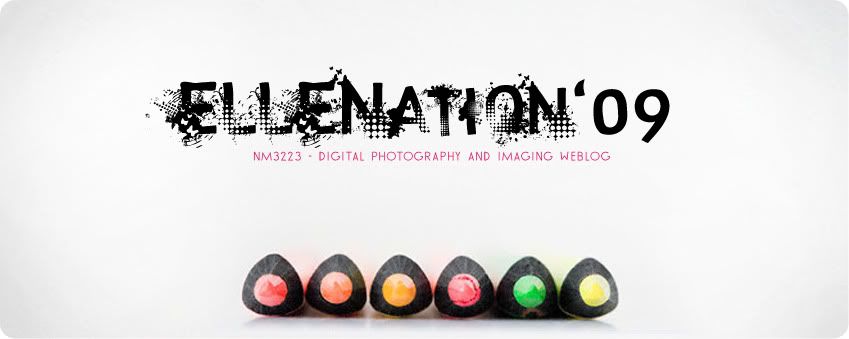Human:nature, due to the “word’s” ambiguity, I had various impressions of the theme. I guess this is what allowed all of us different interpretations of the theme:
I did some research on the national flower, and found that actual orchid (flowers) were used in the process of souvenir making. Which means that the end user could actually end up getting the real flower, plus the metal that comes with it. Orchids are sent for electro-plating, and gold is used as electrolyte. Hence, some of the souvenirs that we see in gift shops, as well as gifts to important guests and ministers are gold-plated orchids.
The story follows that of a how to acquire Nature-infused Jewellery into your own home.

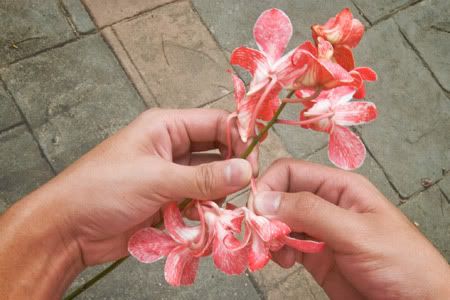
step three
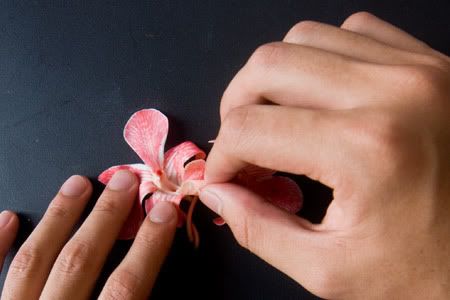
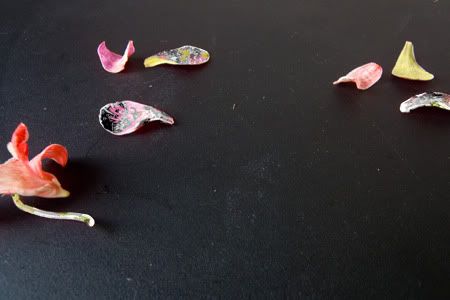
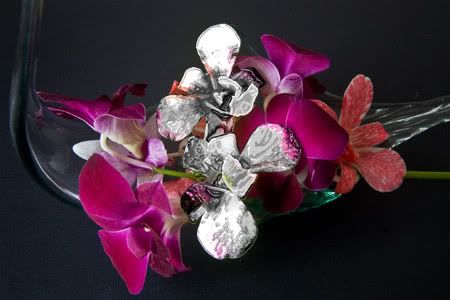
The last scene shows the final product – leaving the finished-product inside a dish of flowers. My aim is to invoke a sense of familiarity in the viewer. It is interesting how jewellery can be made to as life-like as the real flower, and that when placed side-by-side, it really is a fuse of nature and man-made objects, with the jewellery itself already fusing both.
To achieve the jewelled state of the orchid, I used various functions in Photoshop to create the effect. Because I only wanted to “metal-lise” 2 flowers, I cropped them out and used “Custom Black & White” to get the shadows in the figure on the left. Because I imagine my end product to be metallic and reflective, I rendered the levels such that I had strong shadows and highlights but still had some midtones, and then Posterising the outcome till I had simplified shadows.
Then I explored the Filter Gallery. I found that Plastic Wrap and Chrome have very nice reflective outcomes, but both filters do not work together without some overlaying. Therefore I had to create multiple layers and work the filters on both layers separately. In the end, I found that overlaying the Chrome layer in Vivid Light on the Plastic Wrap filtered layer has a great effect, after adjusting opacity levels.
It was not enough to simply paste the finished product into this scene, as it simply looked like it was floating. Hence, I used the colour replacement tool to put some colours onto the petals that would reflect light, as well as colour from the neighbouring flowers.
- What first came to mind was Human Nature, the intrinsic characteristics of mankind. I thought about the bad habits that were characteristics of Singapore residents – littering, being inconsiderate (pretending to sleep in front of an old lady on public transportation).
- Then I linked this to the 7 deadly sins, since these are 7 traits in humans that are difficult to erase and avoid. I thought about the execution, instead of getting actors to portray the emotions on their faces, I thought I would do B&W photography of just hands. Maybe a pair in one, and 2 pairs in some. Maybe parts of body to be included, but no faces will be shown. I was very hooked onto this idea, and I knew this would be a great constraint to me. I wanted to get different pairs of hands for each trait. For example, I wanted a couple for “lust”, and an old man’s hand with huge gold rings on it. But some I knew it would be quite difficult to get willing actors. I didn’t want this project to be tarnished by cliché images, for the theme in itself is a widely popular subject. I will put this as a personal project on the sidelines and do it during the holidays when I get to see all my relatives.
- I also thought about Human VS Nature, how a jungle island that used to be Singapore, is now a cement jungle instead. I used to have a piece of small, green highland the size of 2 football fields right opposite my house, and now it’s a construction site for a new condominium.
- Then I thought deeper and came to realize the similarity of humans and plants. For example, ginseng is one plant that closely resembles the human body. I thought I could develop an “Evolution” of a series of 5-6 pictures.
- The last idea is the one that I am going to develop for this project. Humans have a tendency to take elements of things that are pleasing to the eye, and try to make it their own. And it is no surprise that much of the inspiration for art and jewellery come from Mother Nature. Elements such as organic lines, flows, and shapes are inspired by the dainty and beautiful flowers, and have been made into souvenirs, jewellery, embellishments etc.
I did some research on the national flower, and found that actual orchid (flowers) were used in the process of souvenir making. Which means that the end user could actually end up getting the real flower, plus the metal that comes with it. Orchids are sent for electro-plating, and gold is used as electrolyte. Hence, some of the souvenirs that we see in gift shops, as well as gifts to important guests and ministers are gold-plated orchids.
The story follows that of a how to acquire Nature-infused Jewellery into your own home.
step one

step two

step three

step four

step five

Instead of displaying the utensils that are used to make this precious flower, I decided to omit this scene, and have a scene of broken petals that are left behind, with no main flower in sight. This is done so as to create some sense of mystery as to what happened to the flowers.
The last scene shows the final product – leaving the finished-product inside a dish of flowers. My aim is to invoke a sense of familiarity in the viewer. It is interesting how jewellery can be made to as life-like as the real flower, and that when placed side-by-side, it really is a fuse of nature and man-made objects, with the jewellery itself already fusing both.
To achieve the jewelled state of the orchid, I used various functions in Photoshop to create the effect. Because I only wanted to “metal-lise” 2 flowers, I cropped them out and used “Custom Black & White” to get the shadows in the figure on the left. Because I imagine my end product to be metallic and reflective, I rendered the levels such that I had strong shadows and highlights but still had some midtones, and then Posterising the outcome till I had simplified shadows.
Then I explored the Filter Gallery. I found that Plastic Wrap and Chrome have very nice reflective outcomes, but both filters do not work together without some overlaying. Therefore I had to create multiple layers and work the filters on both layers separately. In the end, I found that overlaying the Chrome layer in Vivid Light on the Plastic Wrap filtered layer has a great effect, after adjusting opacity levels.
It was not enough to simply paste the finished product into this scene, as it simply looked like it was floating. Hence, I used the colour replacement tool to put some colours onto the petals that would reflect light, as well as colour from the neighbouring flowers.
Labels: FINAL PROJECT
